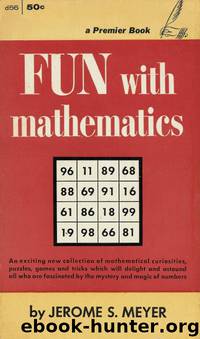Fun With Mathematics by Jerome S. Meyer

Author:Jerome S. Meyer [Meyer, Jerome S.]
Language: eng
Format: epub
Tags: Mathematics
Published: 0101-01-01T00:00:00+00:00
All even powers of i are either −1 or +1 and whenever you see i2 you can be sure that it is −1, while i4 is +1 and so on. It follows from this that 8i2 is −8 and 29i4 is +29, and so on. These imaginary numbers, which appeared at first to exist only in the » imagination and to have no real significance, actually transform themselves into real numbers when raised to even powers.
A most fascinating discovery was that every number has n nth roots: 7, for example, has 3 cube roots, 5 fifth roots, and so on; and so has 16, for any number at all has n nth roots. Maybe this is not news to you, but ask anyone you know (provided he is not a mathematician) what the cube root of 8 is. He will say “2” just ; like that. But he is only one third correct. There are two other cube roots of 8 and, while we can’t conceive them since they are what we call complex numbers, they exist nevertheless. This is extremely interesting. Here are two inconceivable numbers that we can’t use at all, yet if either of them is cubed it will give the answer of 8. To prove this let us examine the three cube roots of 8. They are: 2, −1 + i√3 and −1 − i√3. Let us cube this −1 + i√3 and see if it actually gives us 8. Remember that i2 = −1 and 3i2 = −3.
−1 + i√3
−1 + i√3
+1 − i√3
+1 − i√3 − 3 (i√32 = 3i2 = −3)
−2 − 2i√3
Now
−2 − 2i√3
−1 + i√3
+2 + 2i√3
− 2i√3 − (−6) (−2 × 3i2 = −2 × −3 = +6)
+2 +6
2 + 6 = 8
So we see that the cube of −1 + i√3, which is a complex number or the combination of a real and an imaginary number, actually turns out to be 8. The same result would be obtained if we cubed the other complex number −1 − i√3. So 8 has three cube roots, one real and two imaginary.
In the same way there are five fifth roots of 32, ten tenth roots of 1024 and so on. Every number has n nth roots; but in every case the maximum number of real roots—composed of numbers that we use every day—is two regardless of how many roots the number has.
This is beautifully shown and explained by graphic representation. Figure 37 shows the regular X and Y axis so familiar to all who work with graphs. Let us call the +1 on the X axis B and the −1 on the X axis A. Let us also call the +1 on the Y axis P. If we now join A and B to P forming two equal right triangles, we have the well known relation: OA : OP = OP : OB because angle APB is a right angle and all the triangles are similar. It follows from this that OP = OA × OB or OP = +1 × −1 = −1.
Download
This site does not store any files on its server. We only index and link to content provided by other sites. Please contact the content providers to delete copyright contents if any and email us, we'll remove relevant links or contents immediately.
On Writing A Memoir of the Craft by Stephen King(4863)
The Doodle Revolution by Sunni Brown(4685)
A Simplified Life by Emily Ley(4099)
Mummy Knew by Lisa James(3632)
Marijuana Grower's Handbook by Ed Rosenthal(3620)
Better Homes and Gardens New Cookbook by Better Homes & Gardens(3525)
Figure Drawing for Artists by Steve Huston(3381)
Paper Parties by Erin Hung(3371)
Draw Your Day by Samantha Dion Baker(3289)
The Genius of Japanese Carpentry by Azby Brown(3224)
Japanese Design by Patricia J. Graham(3109)
The Code Book by Simon Singh(3074)
Dangerous Girls by Haas Abigail(2976)
Lions and Lace by Meagan Mckinney(2924)
The Curated Closet by Anuschka Rees(2913)
How to Make Your Own Soap by Sally Hornsey(2827)
The Checklist Manifesto by Atul Gawande(2779)
The Wardrobe Wakeup by Lois Joy Johnson(2732)
Zero to Make by David Lang(2726)
